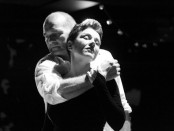Bill T. Jones/Arnie Zane Company: Analogy Trilogy
Jones has become known for applying his wide-ranging choreography and sharp mind to storylines that take on chunks of history—including some shockingly modern history. He displays his sharp observational abilities in Analogy Trilogy, each part luxuriating in the slow, detailed unraveling of the stories of three interesting people: Dora Amelan, a Belgian Holocaust survivor; Lance, a seventies’ drug, sex and phony fame survivor; and the surreal Ambrose, the Emigrant who accompanies a rich, detached Jew on his odd journeys through America and Europe in the early twentieth century. [more]




